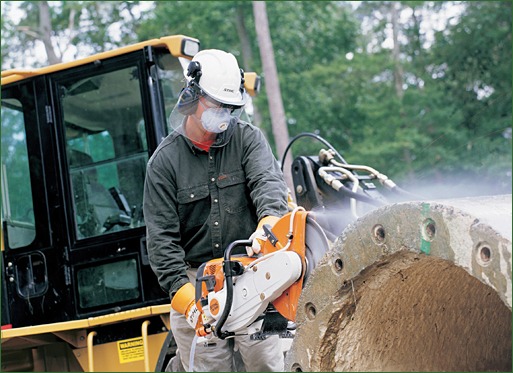Which Wheel is Right for Your Job?
Words: Dan Kamys
Saw Blades
By Adam Hanks

In recent years, diamond wheels have become increasingly important in the construction industry for cutting concrete, asphalt and stone. There is a wide variety of diamond wheels available, and, with so many choices, contractors and purchasing agents wonder what wheels are the best fit for their application. Understanding what components a diamond wheel is made from, how a diamond wheel works and what types of diamond wheels are available can help these construction professionals make better buying decisions.
Components of a diamond wheel
In order to understand how a diamond wheel works, it is important to first understand what components go into a diamond wheel. The first component of a good diamond wheel is a steel core that is tensioned to ensure that the wheel does not wobble or distort when a load is applied. The next component is the diamonds, which do most of the work, and quality wheels use diamonds of consistent size and shape for better cutting performance and longer tool life. The last component is the bond matrix that holds the diamonds in place. The bond matrix is made up of different recipes of powdered metals designed for specific types of materials. The diamonds are mixed into the bond matrix and then “cooked” under high pressure and high temperature to create the diamond segment in a process called sintering. This segment is attached to the steel core by either brazing, direct sintering or laser welding. Laser welding is the most expensive in terms of manufacturing but provides the most durable bond between the core and the diamond segment.
How diamond wheels work
Knowing the components makes understanding the operation of the wheel much easier. There are exposed diamonds on the surface of each segment and these diamonds grind away material as the diamond wheel is rotated. As the diamonds wear away the material, the bond matrix between the diamonds is also being worn away exposing new diamonds. The diamonds wear down, shatter or are pulled out of the bond matrix as part of the normal wear process as wheels are used. The powdered metals used in the bond matrix are designed to wear away only as fast as diamonds are being used up, so it is important to use the correct diamond wheel for a given application. Hard materials such as reinforced concrete, brick and stone require a diamond wheel with a softer bond matrix that wears away faster and exposes more diamonds in order to maintain the wheel’s performance. Cutting a hard material with a wheel that has a hard bond could cause the wheel to glaze, or become polished, and not cut well. Soft materials, such as asphalt, sandstone or green concrete, require wheels with a harder bond that exposes the diamonds at a slower rate. Cutting soft material with a wheel that has a soft bond would cause the wheel to wear down quickly and waste the wheel.
Different types of diamond wheels
Aside from different bond configurations and diamond concentrations, there are also different types of diamond wheels. The most common wheel on larger handheld and walk-behind units are segmented wheels where each diamond segment is separated by a gullet. The gullet is designed to carry away material during cutting, especially if water is used for dust suppression. The continuous-rim diamond wheel has a continuous diamond segment along the entire radius of the wheel. These wheels run hotter than segmented wheels, are less likely to chip and provide a smooth cut in materials like ceramic tile, so are often used on wet tile saws. Turbo wheels look very similar to continuous rim wheels but have small indentions in the diamond segment. These wheels are use on handheld cut-off machines and also provide a smooth cut. These wheels are used frequently on landscaping materials where the cut edge may show.
Diamond wheels seem to be very simple on the surface, but there are many things to consider when selecting a quality diamond wheel. Knowing what makes up a diamond wheel, how it works and what types of wheels are available can help construction professionals make better buying decisions. Your local servicing dealer is also a good resource to help ensure you get the best wheel for your needs. While the construction market is very cost sensitive, it is important to remember that inexpensive diamond wheels may cost more money in the long term and increase the risk of injury to the operator and bystanders. Such risks include injury from thrown tips and reactive forces. The paramount concern for any tool is that it is safe for the operator, so always match the type of diamond wheel to the job being done and always follow direction in the manufacturer’s instruction manual.
Return to Table of Content